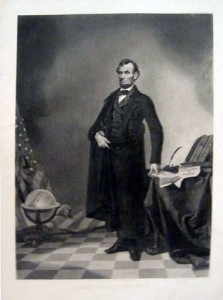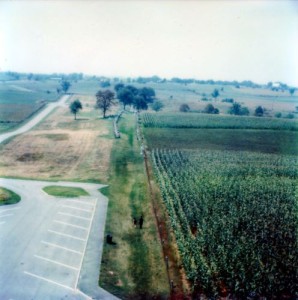Visions on Earth, by Tom O’Neill, photographs by Abelardo Morell
Morell has decided to take photographs of the National Parks of the Western United States with a camera obscura. I’m not sure exactly how the science works, and I’m sure that if I tried it, it would fail miserably, but apparently somehow, if you make a room completely dark and then poke a hole in the object darkening the room, it somehow turns the light outside into a projector and you can see an upside-down version of the view outside on the wall of the room. I’m sure that if I tried it, I would just get a pinhole of light on the wall. I can make even the simplest things unbearably complicated.
But apparently this technique works for Morell. And so Morell, with the help of his assistant, C.J. Heyliger, has designed a completely dark tent with a pinhole in it. Morell takes this tent out to National Parks and uses it to take camera obscura photos of the parks projected on the ground under the tent. The result is photographs of, for example, Old Faithful and the people surrounding it on a background of rocks and twigs. The images that result are beautiful and worth the time to look at. If you don’t have a subscription to National Geographic, some of these photographs (including others taken in cities including Rome, Florence and New York City) are available at Morrell’s website (my one criticism of the site is that the caption shows up for a fraction of a second and I cannot make them show up long enough to read).
Building the Ark, by Elizabeth Kolbert, photographs by Joel Sartore
Building the Ark is about the role of zoos in preserving threatened and endangered species and also about the perception that only the big mammals will bring people, and thus money, to the zoos. This is particularly important since most of the threatened and endangered species in the world are amphibians.
Onnie Byers, of the International Union for Conservation of Nature suggests that zoos should gradually phase out species that are not yet in dire need of preservation in favor of ones that need the help more urgently.
Kolbert gives us the example of the Kihanzi spray toad of Tanzania (I had the worst time trying to type “Kihanzi” and I’m not entirely sure I have it right yet). The toad was discovered during the construction of a dam. The government of Tanzania realized that the dam project would likely wipe the toad out and so 499 toads were captured. Half were sent to the Bronx Zoo and half to the Toledo Zoo. Soon after the toads were brought into captivity, a fungus wiped out the population in the wild. This meant that the survival of the species depended on less than 500 individuals left in the zoos. Fortunately, the zookeepers were able to induce the frogs to reproduce and in 2010 a hundred were sent to the University of Dar es Salaam in Tanzania. In 2012, some of the toads were released into the wild.
Then there is the “frozen zoo.” The San Diego Zoo has a room dedicated to saving the few living cells of species that are about to go, or have just gone, extinct. Those cells are not necessarily reproductive. One example given is the po’ouli, a Hawaiian bird, the last example of which was sent to San Diego after his death. The only cells that the zoo was able to culture were from the bird’s eye, so they were frozen in liquid nitrogen against the day that science could resurrect the bird.
The Visual Village, by James Estrin
We’re back to the one of the themes this issue started with, that everyone has his or her own camera today and thus the nature of photography is changing. Pictures of unfolding events can be shared on the spot, rather than having to wait for a professional to arrive. This one has less of the dismissiveness than I sensed from Draper’s writing and more hope. In particular, Estrin acknowledges that many of the photographs being taken by average citizens are very good and that it is an excellent way to expose things like the abuses of those in power to the light. This will perhaps lead to less of the abuse of the powerless by the powerful.

There is one comment that Estrin makes that I have to comment on, however. Estrin says, “Before digital images most people considered photographs to be accurate renderings of reality,” and then goes on to say that with digital image manipulation, now “the average viewer” cannot trust the pictures they see unless it comes from a trusted “news organization or photographer.” I guess that citizen photographers could be considered that kind of photographer, if, for example, they know the photographer personally, or have a friend or acquaintance in common. But photomanipulation goes back before the days of digital computing. A famous photograph of Lincoln (see image above) is actually a photograph of John Calhoun with Lincoln’s head pasted on. And one of the first manipulated photographs was also a selfie. Hippolyte Bayard felt slighted over not being named one of the inventors of photography by the French government, so he took a picture of himself looking like he’d drowned and then darkened his feet and hands to look like decomposition. Bayard lived another 47 years after his apparent suicide.

